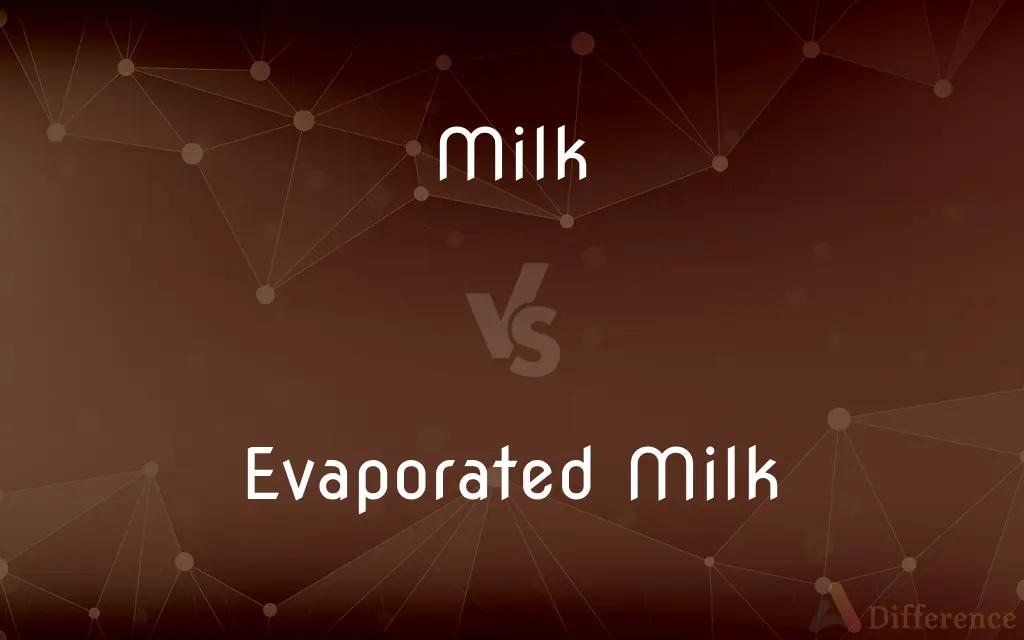Milk vs. Evaporated Milk — What's the Difference?
Edited by Tayyaba Rehman — By Maham Liaqat — Published on June 28, 2024
Milk is a natural liquid from mammals, rich in nutrients, while evaporated milk is milk with 60% of water removed, used for a creamier texture in recipes.

Difference Between Milk and Evaporated Milk
Table of Contents
ADVERTISEMENT
Key Differences
Milk, a staple in many diets, is a natural liquid produced by mammals, offering essential nutrients like calcium, protein, and vitamins. Evaporated milk, on the other hand, is a processed form of milk where about 60% of the water content has been removed. This process not only extends the shelf life of the milk but also concentrates its flavors and nutrients, resulting in a creamier and richer texture than regular milk. Evaporated milk is especially popular in cooking and baking, where it adds a dense richness to dishes without adding excess water.
The production process of evaporated milk involves heating regular milk under reduced pressure, which allows for water evaporation at lower temperatures, preserving the taste and nutrients effectively. This contrasts with the simple pasteurization process that regular milk undergoes to kill bacteria. Because of its reduced water content, evaporated milk has a slightly caramelized flavor and color, distinguishing it from the fresh taste of regular milk.
Nutritionally, evaporated milk is denser in nutrients compared to an equivalent volume of fresh milk due to the concentration process. However, it's important to note that the vitamin content can be slightly lower in evaporated milk, as some vitamins are sensitive to heat and may be partially lost during processing. Evaporated milk can be reconstituted by adding water to reach a consistency similar to regular milk, making it a versatile ingredient in the kitchen.
In terms of storage, evaporated milk boasts a significantly longer shelf life than fresh milk, requiring no refrigeration until opened, which makes it an excellent staple for pantry storage. This long shelf life is due to the removal of water, which inhibits the growth of microorganisms. Regular milk, requiring refrigeration, typically has a shelf life of about 5 to 7 days once opened.
Both milk and evaporated milk hold nutritional value and can be used interchangeably in some recipes, but their differences in texture, taste, and storage requirements make each unique in culinary applications. Choosing between them depends on the desired outcome in cooking or baking, with evaporated milk offering a richer, more concentrated flavor and texture.
ADVERTISEMENT
Comparison Chart
Definition
Natural liquid from mammals
Milk with 60% of water removed
Processing
Pasteurized to kill bacteria
Heated under reduced pressure to remove water
Flavor
Fresh and natural
Creamier, slightly caramelized
Nutritional Content
Rich in calcium, protein, vitamins
Denser in nutrients, slight vitamin loss
Uses
Drinking, general cooking, and baking
Cooking and baking for richer texture
Storage
Requires refrigeration
No refrigeration needed until opened
Shelf Life
5-7 days after opening
Longer, until opened
Compare with Definitions
Milk
A nutritious liquid produced by mammals.
A glass of milk is rich in calcium.
Evaporated Milk
Ideal for cooking and baking.
Use evaporated milk for a richer mac and cheese.
Milk
Offers a natural taste.
Fresh milk tastes great with cookies.
Evaporated Milk
Can be diluted to mimic fresh milk.
Mix water with evaporated milk for a milk substitute.
Milk
Used widely in beverages and recipes.
Milk is a key ingredient in smoothies.
Evaporated Milk
Concentrated milk with reduced water content.
Evaporated milk adds creaminess to coffee.
Milk
Requires refrigeration to maintain freshness.
Store milk in the fridge to keep it fresh.
Evaporated Milk
Stores well in the pantry.
Keep evaporated milk on hand for emergency baking needs.
Milk
Contains a balanced mix of nutrients.
Milk is a good source of vitamin D and protein.
Evaporated Milk
Has a slightly caramelized flavor.
Evaporated milk gives a rich taste to pumpkin pie.
Milk
A whitish liquid containing proteins, fats, lactose, and various vitamins and minerals that is produced by the mammary glands of all mature female mammals after they have given birth and serves as nourishment for their young.
Milk
(uncountable) A white liquid produced by the mammary glands of female mammals to nourish their young. From certain animals, especially cows, it is also called dairy milk and is a common food for humans as a beverage or used to produce various dairy products such as butter, cheese, and yogurt.
Skyr is a product made of curdled milk.
Milk
A white fluid secreted by the mammary glands of female mammals for the nourishment of their young, consisting of minute globules of fat suspended in a solution of casein, albumin, milk sugar, and inorganic salts.
Milk
To draw anything from, as if by milking; to compel to yield profit or advantage; to plunder.
They [the lawyers] milk an unfortunate estate as regularly as a dairyman does his stock.
Milk
Produced by mammary glands of female mammals for feeding their young
Common Curiosities
Is evaporated milk healthier than regular milk?
It's denser in nutrients per volume but may have slightly lower vitamin content due to heat processing.
Why does evaporated milk have a longer shelf life than regular milk?
The removal of water inhibits the growth of microorganisms, extending its shelf life.
Can evaporated milk be used as a direct substitute for regular milk?
Yes, by diluting it with water, but the slightly caramelized flavor may affect the taste of the final product.
How do you store evaporated milk after opening?
It should be transferred to an airtight container and refrigerated, similar to fresh milk.
Can I drink evaporated milk straight from the can?
Yes, but its rich and slightly different taste may not be appealing to everyone as a drink.
Is there a difference in calcium content between milk and evaporated milk?
Evaporated milk has a higher calcium content per volume due to the concentration process.
Why does evaporated milk taste slightly caramelized?
The heating process during its production can cause slight caramelization of the sugars in the milk.
Is evaporated milk suitable for making cheese?
It's not typically used for cheesemaking due to its altered protein structure from heat treatment.
Can evaporated milk be used in coffee?
Yes, it's often used to add a rich, creamy texture and flavor to coffee.
What's the environmental impact of producing evaporated milk compared to regular milk?
Evaporated milk requires less refrigeration before opening, which may reduce energy use, but the processing has its own environmental costs.
How can I use evaporated milk in baking?
It can be used to add richness to cakes, cookies, and other desserts.
How do I reconstitute evaporated milk to use as regular milk?
Mix it with an equal part of water to approximate the texture and dilution of regular milk.
Does evaporated milk need to be diluted for all cooking uses?
Not always; it depends on the recipe and whether it calls for milk's flavor or its liquid content.
What makes evaporated milk creamier than regular milk?
The removal of water concentrates its fat and protein content, giving it a creamier texture.
Can lactose-intolerant individuals consume evaporated milk?
It contains lactose, so those with lactose intolerance should be cautious or seek lactose-free alternatives.
Share Your Discovery

Previous Comparison
ChatGPT vs. Stockfish
Next Comparison
Muslim vs. ArabsAuthor Spotlight
Written by
Maham LiaqatEdited by
Tayyaba RehmanTayyaba Rehman is a distinguished writer, currently serving as a primary contributor to askdifference.com. As a researcher in semantics and etymology, Tayyaba's passion for the complexity of languages and their distinctions has found a perfect home on the platform. Tayyaba delves into the intricacies of language, distinguishing between commonly confused words and phrases, thereby providing clarity for readers worldwide.













































